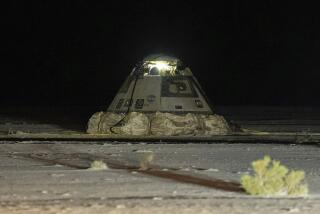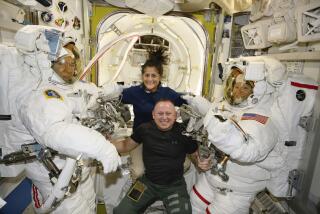2 Cosmonauts Return Safely on 3rd Attempt : Soviet and Afghan Land in Central Asia After 2 Failures; Oxygen Running Low on Spaceship
- Share via
MOSCOW — Two cosmonauts, whose spacecraft had less than two days’ worth of remaining oxygen and internal power, returned safely to Earth early today after failing twice on Tuesday, the Soviet news agency Tass reported.
The two spacemen, veteran Soviet cosmonaut Vladimir Lyakhov, 47, and Abdul Ahad Mohmand, 29, a pilot from Afghanistan, who were returning from a week aboard the Soviet Union’s orbiting Mir space station, were reported well.
They had been unable to land in two attempts on Tuesday when automatic equipment aboard their Soyuz spacecraft failed to function properly, prompting concern for their safety.
Landing in Kazakhstan
The cosmonauts landed in Soviet Central Asia, their designated landing area, about 100 miles southeast of the town of Dzhezkazgan in Kazakhstan, according to the Soviet news agency.
Tass said they landed at 4:50 a.m. Moscow time today (5:50 p.m. PDT Tuesday) after a 49-minute descent from their final orbit around the Earth.
After the two aborted descents from the spacecraft’s orbit, “the mission control center carried out a thorough analysis of the situation and adopted the necessary decisions to secure the normal landing of the spacecraft. . . ,” Tass said in its report of the safe landing.
Radio Moscow reporters at the mission control here reported that the re-entry maneuvers were accomplished “normally and safely,” but no further details were immediately available from the Soviet space agency, Glavkosmos.
On Tuesday evening, control center officials had indicated that the two cosmonauts had only enough oxygen for 48 hours and only emergency food stocks aboard their Soyuz spaceship. Their internal power supplies were also described as very limited.
“The situation is serious, but the specialists hope that the landing will proceed normally,” the government newspaper Izvestia reported then.
The Soyuz spacecraft would not have had the capability of returning to the Mir space station, which it left Monday, but officials from Glavkosmos would not be drawn into speculation on what might have happened had the cosmonauts been unable to land today.
“Don’t worry, nothing terrible has happened,” Valery Ryumin, an official at the mission control center, earlier told Izvestia. But Ryumin added that, after two equipment failures, the Soyuz crew might have been forced to descend using manual rather than automatic controls in order to end the flight as soon as possible.
Tass said the landing was preceded by a “guided descent” but did not indicate whether this was directed from the mission control center here or whether the cosmonauts were able to reset the spacecraft’s automatic landing system.
The main concern, however, had been the limited oxygen aboard the spacecraft.
Tass also had said Tuesday night that the cosmonauts “are in for difficult hours in orbit until the designated time of landing; the descent vehicle in which they are now is not provided with everyday living facilities.”
U.S. Offer of Aid
The cosmonauts’ predicament brought an offer of assistance Tuesday from the National Aeronautics and Space Administration, which said its global space tracking and communications system--more sophisticated than the Soviets’--could keep constant contact with the spacecraft.
Although the Soviet mission control center initially turned down the U.S. offer, saying the problems were “minor” and that no assistance was required, NASA had renewed it Tuesday evening in a cable to Moscow.
“We saw reports that (the situation) may be more serious, and we stand by ready to help,” Jennifer Clapp, a NASA spokeswoman, had said in Washington. “The news from Moscow was so striking that we wanted to help.”
Although the United States and the Soviet Union do not have an agreement providing for cooperation on manned space flights, President Reagan and Mikhail S. Gorbachev, the Soviet leader, did agree last year on closer cooperation in space sciences.
The first re-entry attempt failed, according to Soviet space officials, when rays from the sun--as the spacecraft orbited from night into day--prevented the operation of an infrared sensor that enables the Soyuz to orient itself based on the thermal radiation from Earth.
As a result, the spacecraft’s engine turned on too late, cosmonaut Alexander Alexandrov told Soviet journalists at the mission center. Re-entry then would have meant overshooting the planned landing area by 435 to 500 miles and perhaps coming down across the Soviet border in China.
The spacecraft’s motor was turned off, Alexandrov said, and preparations were made for a second re-entry attempt three hours later on a subsequent orbit with the data needed for orientation taken from the Soyuz computer.
But that attempt failed, according to Alexandrov, because the spaceship’s automatic equipment had not been fully reset after the first try, and the engine fired for only six seconds rather than the nearly four minutes required.
The mission control center then decided to postpone the landing until today.
Sergei Zagorodny, a spokesman for Glavkosmos, said earlier that the mission control center had been in radio contact with the cosmonauts and was confident that they would be able to land today.
“The cosmonauts must now choose another descent path,” he had said, adding that they would either have to reprogram the computer for an automatic landing or descend using manual controls to land in Kazakhstan.
The cosmonauts themselves were reported to have taken their predicament without concern.
“There is food, but we won’t touch it,” Izvestia quoted Lyakhov as saying as he joked about preferring to defer lunch rather than tax the spacecraft’s limited sewage disposal system. “There’s never been anything like this.”
Lyakhov and Mohmand, accompanied by Valery Polyakov, a Soviet cosmonaut-physician, blasted off from Baikonur, the Soviet launch center in Kazakhstan, on Aug. 29 in a mission that the Soviet Union and Afghanistan hailed as marking their cooperation in peace after the long Soviet involvement in the Afghan civil war.
The three docked with the orbiting Mir space station two days later, joining two other Soviet cosmonauts already on board. On Monday, they were shown on Soviet television announcing the completion of their week of research and their plans to return to Earth.
Polyakov, 46, stayed on Mir to monitor the health of the other cosmonauts, Vladimir Titov and Musa Manarov, who were launched last Dec. 21 and are due to set a space endurance record by remaining in orbit a full year.
The research done by the Soviet-Afghan mission included space photography of remote regions of Afghanistan to search for mineral and water resources and to plan the country’s economic development.
The spacecraft on which they returned, the TM-5, had been left docked with the Mir space station in June by a joint Soviet-Bulgarian crew, and their launch ship, the Soyuz TM-6, is now docked at Mir.
More to Read
Sign up for Essential California
The most important California stories and recommendations in your inbox every morning.
You may occasionally receive promotional content from the Los Angeles Times.










